Arkansas Quartz - Can You Dig It?
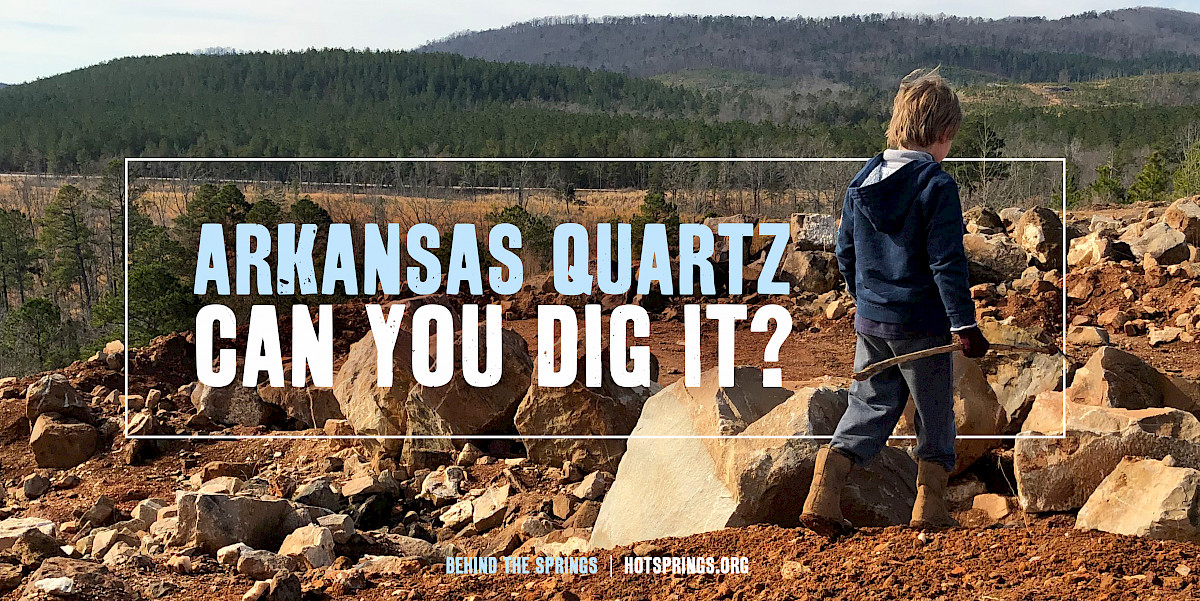
Photo courtesy of Nichole Holze, @coleyraeh, luckeywanderers.com
Nature’s perfection is spellbinding… the symmetry of a butterfly’s wings, the spiral of a seashell, the complexity of a silky spiderweb.
Patterns found throughout the universe have captivated scientists and mathematicians for centuries – patterns in pine cones and sunflowers that are mirrored in the whirl of a hurricane and the arms of our galaxy. Mankind has long been transfixed by the natural world. Looking to the sky for answers and finding patterns in the stars. Equally mesmerizing are the twinkling formations found underfoot – perfectly formed crystals created by ancient geological activity.

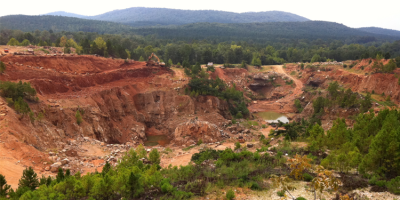 The Ouachita Mountains in west-central Arkansas are a place of wonder where silica-rich water and a little bit of luck created some of the world’s largest and finest deposits of quartz crystals. Unlike other mountain ranges in North America, which run north to south, the Ouachita Mountains run east to west, stretching 225 miles from central Arkansas to eastern Oklahoma. The quartz occurs in a narrow belt about 30 miles wide and 170 miles long, but the clearest points and the largest clusters are found in the mountains surrounding Hot Springs. Specimens from nearby mines have made their way to museums, galleries and private collections all around the world.
The Ouachita Mountains in west-central Arkansas are a place of wonder where silica-rich water and a little bit of luck created some of the world’s largest and finest deposits of quartz crystals. Unlike other mountain ranges in North America, which run north to south, the Ouachita Mountains run east to west, stretching 225 miles from central Arkansas to eastern Oklahoma. The quartz occurs in a narrow belt about 30 miles wide and 170 miles long, but the clearest points and the largest clusters are found in the mountains surrounding Hot Springs. Specimens from nearby mines have made their way to museums, galleries and private collections all around the world.
Ron Coleman Mining, located about 30 minutes from downtown Hot Springs, is renowned for producing mammoth clusters – the largest measuring 9-feet long and weighing 3,000 pounds. The public is invited to dig for their own treasures in the tailings – dirt that has been excavated from the mine. The mine owners guarantee that visitors will find enough quartz to cover the cost of digging or receive credit to use in their gift shop. It’s a popular destination for beginners as well as seasoned rockhounds. The mine is open seven days a week, 8 a.m. to 4:30 p.m.

 Nearby Avant Mining has also produced some spectacular pieces. They have specimens that are now in collections at the Smithsonian National Museum of Natural History, the American Museum of Natural History, Yale University, and Harvard University. But the company’s most prized specimen, dubbed “The Holy Grail,” remains in state – at the Crystal Bridges Museum of American Art in Bentonville. Measuring five feet tall, the exceptionally large cluster features a four-foot long point rising from the matrix.
Nearby Avant Mining has also produced some spectacular pieces. They have specimens that are now in collections at the Smithsonian National Museum of Natural History, the American Museum of Natural History, Yale University, and Harvard University. But the company’s most prized specimen, dubbed “The Holy Grail,” remains in state – at the Crystal Bridges Museum of American Art in Bentonville. Measuring five feet tall, the exceptionally large cluster features a four-foot long point rising from the matrix.
“That’s considered by most experts to be the best large quartz cluster ever found in Arkansas,” said James Zigras owner of Avant Mining. “It’s really unprecedented.”
Renowned for its clarity, size and form, Arkansas quartz was formed over 300 million years ago from the fewest of ingredients – silicon and oxygen.
“The quartz we have in the Ouachita Mountains formed as hydrothermal waters were moving to the surface during the Ouachita uplift,” explained Doug Hanson, a supervisor with the Arkansas Geological Survey. “The crystals formed as the hydrothermal waters became super saturated with silica, then as the temperature and the pressure decreased, the quartz crystals started forming out of the silica-rich waters.”
Many people unfamiliar with quartz often assume the crystals have been cut and polished, but they naturally occur with six sides that terminate in a point.
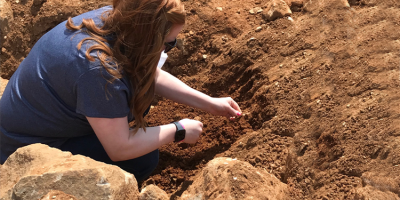 “A quartz crystal’s shape is determined by the molecular structure of the mineral,” said Education Geologist Camille Gernhart, also with the AGS. “In quartz’s case, the silicon and oxygen form a molecule that bonds together to create a hexagonal structure.”
“A quartz crystal’s shape is determined by the molecular structure of the mineral,” said Education Geologist Camille Gernhart, also with the AGS. “In quartz’s case, the silicon and oxygen form a molecule that bonds together to create a hexagonal structure.”
I didn’t know anything about quartz before moving to Hot Springs in 2001 but within my first year here, I met an amateur miner with a van full of paint buckets overflowing with clay-encrusted crystals. A resident of Pennsylvania, he’d been camping in the Ouachita Mountains for several weeks, digging for the much sought-after stones with plans to sell them to metaphysical shops in New England. I was a senior in college at the time, studying creative nonfiction, and I knew then there was an interesting story behind these rare and beautiful formations.
 Arkansas quartz has been prized for thousands of years. Crystal arrowheads dating back to 8,000 B.C. have been discovered in the state. Written accounts and archeological evidence suggest quartz was also used in more recent history by Native Americans to craft arrowheads and tools, and for ceremonial purposes. Quartz’ popularity only grew as Westerners began flocking to the area. By the late 1800s quartz crystals were being mined and sold to health-seekers traveling to Hot Springs for the thermal waters. Today, visitors enjoy mining their own crystals.
Arkansas quartz has been prized for thousands of years. Crystal arrowheads dating back to 8,000 B.C. have been discovered in the state. Written accounts and archeological evidence suggest quartz was also used in more recent history by Native Americans to craft arrowheads and tools, and for ceremonial purposes. Quartz’ popularity only grew as Westerners began flocking to the area. By the late 1800s quartz crystals were being mined and sold to health-seekers traveling to Hot Springs for the thermal waters. Today, visitors enjoy mining their own crystals.
 My first opportunity to write about quartz came in 2007 while working for Hot Springs’ daily newspaper. I was assigned to cover the World Championship Quartz Crystal Dig in Mount Ida, known as “The Quartz Crystal Capital of the World.” Held annually on the second weekend in October, the two-day event invites amateur rockhounds to dig at area mines and compete for cash prizes. At the end of each day, participants may enter one point and one cluster for the competition. The specimens are examined by a panel of judges, and given a monetary value with cash prizes awarded for the top five crystals in each category. Best of all, participants get to keep everything they find.
My first opportunity to write about quartz came in 2007 while working for Hot Springs’ daily newspaper. I was assigned to cover the World Championship Quartz Crystal Dig in Mount Ida, known as “The Quartz Crystal Capital of the World.” Held annually on the second weekend in October, the two-day event invites amateur rockhounds to dig at area mines and compete for cash prizes. At the end of each day, participants may enter one point and one cluster for the competition. The specimens are examined by a panel of judges, and given a monetary value with cash prizes awarded for the top five crystals in each category. Best of all, participants get to keep everything they find.
“It’s a really good experience because the mines do a lot of prep work so it’s usually very abundant for everybody,” said Dominik Schley, who participated in the 2018 Quartz Dig. “I think everybody actually found good stuff and it doesn’t matter if you know about it or don’t because there was surface collecting available and also veins.”
A local rockhound and crystal enthusiast, Schley shares his mining experiences and techniques with viewers via his YouTube Channel Crystals of Arkansas.
“I felt like there was an opening for me to create something that’s meaningful and that can share a lot of information with people and help people find their own crystals,” Schley said.
Originally from Berlin, Germany, Schley has lived in Arkansas for 11 years. He didn’t know anything about the state when he first visited but quickly fell in love with it, attracted largely by the quartz.
“I camped for five days and was digging crystals from sunrise to sunset and rinsing them at night,” he said. “I got totally hooked on it.”
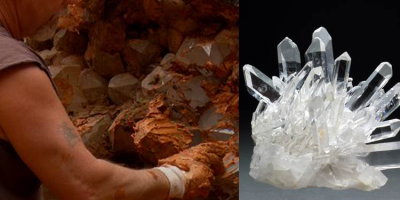 West Central Arkansas is home to a numerous mines where you can dig your own crystals for a small fee including Ron Coleman Mining and Jim Coleman’s Rock Shop & Crystal Mines in Jessieville; and Wegner Quartz Crystal Mines, Sweet Surrender Crystal Mine and Twin Creek Crystal Mine in Mount Ida.
West Central Arkansas is home to a numerous mines where you can dig your own crystals for a small fee including Ron Coleman Mining and Jim Coleman’s Rock Shop & Crystal Mines in Jessieville; and Wegner Quartz Crystal Mines, Sweet Surrender Crystal Mine and Twin Creek Crystal Mine in Mount Ida.
 “I usually recommend all the mines because every mine has a unique habit usually to the crystals and different formations,” Schley said. “Everything about the crystals is usually different for each location so, especially if people are into that, I think it’s really good for them to see the different spots and recognize the different crystal habits.”
“I usually recommend all the mines because every mine has a unique habit usually to the crystals and different formations,” Schley said. “Everything about the crystals is usually different for each location so, especially if people are into that, I think it’s really good for them to see the different spots and recognize the different crystal habits.”
Schley appreciates the natural beauty of quartz but also touts their metaphysical properties. He was a high school student in Germany when he started meditating with crystals and laying them on his body.
“I find it really fascinating how quartz is clear but then it has all the color spectrum in it, when the sun hits it right and then you see the rainbow,” he said. “They say it’s a master healer and it can do anything so I find that fascinating and I think that’s probably why so many people are attracted to it because it does so many different things for so many people.”
Several year’s after writing about Mount Ida’s Championship Quartz Dig, I returned to cover it again, this time with Mineral Explorers, a public televisions series that leads viewers to mines all around the world. The series was created and hosted by Thomas Nagin, a veteran mineral dealer and the owner of Crystal Springs Gallery in downtown Hot Springs. He’d filmed a pilot episode in Colombia and was presented with the “Best Reality Show” Award at the International Television Festival in Los Angeles. I was writing for the state newspaper at the time and was excited to report on this local producer’s big win. Following the interview, I told Nagin that if he needed a writer for the show, I was available. A few weeks later, I received a call. We created two seasons of shows, the first of which included an episode all about Arkansas quartz.
 “Arkansas has what’s renowned as some of the finest quartz in the world,” Nagin said. “I thought it would be a good episode to include because a lot of people are enthusiastic about Arkansas quartz and this is my home base. I was inspired to to move here because of the beauty of Arkansas and its quartz.”
“Arkansas has what’s renowned as some of the finest quartz in the world,” Nagin said. “I thought it would be a good episode to include because a lot of people are enthusiastic about Arkansas quartz and this is my home base. I was inspired to to move here because of the beauty of Arkansas and its quartz.”
As a producer for the show, I had the opportunity to explore mines in Arkansas and even Bolivia, and handle crystals valued at tens of thousands of dollars. I also attended some of the largest gem and mineral trade shows.
Despite my work in the industry – and my expanding rock collection – I’d never actually dug for my own crystals. I’d watched plenty of other people do it including staff at Ron Coleman Mining who extracted a huge quartz cluster right before my eyes.
Earlier this year a friend invited my daughter and me to go digging with her at Wegner Crystal Mines. Owner Richard Wegner opened the mine in 1980 and has always made environmental sustainability a top priority. Their practices include reforestation, and the use solar and wind power, and collected rainwater. They offer a few different mining experiences and we opted for the Crystal Forest Mine, which is a 40 acre open pit surface mine. The ground was literally sparkling beneath my feet. I saw some pretty big clusters and points coming out of this mine during the World Championship Quartz Crystal Dig one year. As novices with small children in tow, we came away with only small points but we found a lot of them and they were all crystal clear.
Tips for Mining and Cleaning
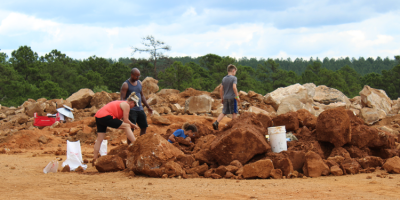
 Seasoned rockhounds say the best time to hunt for crystals is on a sunny day after a rainstorm. The rain washes away loose dirt and the crystals sparkle in the sun. The quartz mines are almost all open-pit mines with little to no shade so you will want to bring water, sunscreen, and a hat. Wear sturdy shoes and work gloves and plan to get dirty. (You might even want to pack an extra set of clothes for the drive home in case you get extra muddy.) Most mines provide tools – some for a fee. Call ahead to find out what they provide or come prepared with a small, sturdy shovel, a heavy duty screwdriver for prying out smaller pieces, a crowbar for larger pieces, and a bucket for all your bounty.
Seasoned rockhounds say the best time to hunt for crystals is on a sunny day after a rainstorm. The rain washes away loose dirt and the crystals sparkle in the sun. The quartz mines are almost all open-pit mines with little to no shade so you will want to bring water, sunscreen, and a hat. Wear sturdy shoes and work gloves and plan to get dirty. (You might even want to pack an extra set of clothes for the drive home in case you get extra muddy.) Most mines provide tools – some for a fee. Call ahead to find out what they provide or come prepared with a small, sturdy shovel, a heavy duty screwdriver for prying out smaller pieces, a crowbar for larger pieces, and a bucket for all your bounty.
 When the crystals come out of the ground, they are often caked in mud and covered in orange iron stains and black manganese. To make them sparkle, give them an oxalic acid bath. Oxalic acid can be purchased at pool supply stores or online. (Some of the crystal mines sell it as well.) It’s a mild acid, but you should always wear gloves and googles and use it outdoors only. First give your crystals a high-pressured wash with a garden hose. Let them dry, then brush away any remaining clumps of dirt with an old toothbrush. Rinse and repeat as needed. After all the dirt has been removed, they’re ready for the oxalic acid, which will remove the iron stains and manganese. In a large bucket, mix about one pound of oxalic acid to five gallons of water. Soak the crystals for three to five days, and then give them another good rinse. Don’t forgot your gloves and safety goggles.
When the crystals come out of the ground, they are often caked in mud and covered in orange iron stains and black manganese. To make them sparkle, give them an oxalic acid bath. Oxalic acid can be purchased at pool supply stores or online. (Some of the crystal mines sell it as well.) It’s a mild acid, but you should always wear gloves and googles and use it outdoors only. First give your crystals a high-pressured wash with a garden hose. Let them dry, then brush away any remaining clumps of dirt with an old toothbrush. Rinse and repeat as needed. After all the dirt has been removed, they’re ready for the oxalic acid, which will remove the iron stains and manganese. In a large bucket, mix about one pound of oxalic acid to five gallons of water. Soak the crystals for three to five days, and then give them another good rinse. Don’t forgot your gloves and safety goggles.

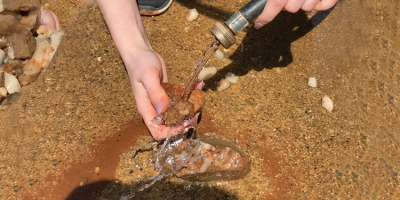 But you don’t have to get your hands dirty to get your hands on some Arkansas quartz. You can buy quartz directly from the mines or at various rock shops and showrooms. All Things Arkansas, located in the heart of downtown Hot Springs, was opened in 2013 by Lisa Coleman Carey, who’s family has owned and operated Ron Coleman Mining for over 30 years. She sells products from Arkansas, made in Arkansas or relating to Arkansas including clusters and points from her family’s mine.
But you don’t have to get your hands dirty to get your hands on some Arkansas quartz. You can buy quartz directly from the mines or at various rock shops and showrooms. All Things Arkansas, located in the heart of downtown Hot Springs, was opened in 2013 by Lisa Coleman Carey, who’s family has owned and operated Ron Coleman Mining for over 30 years. She sells products from Arkansas, made in Arkansas or relating to Arkansas including clusters and points from her family’s mine.
Arkansas quartz comes in all sizes and price points and is a must-have for all mineral collectors, but even novices are in awe of its beauty and form. To hold a quartz crystal is to ponder the mysteries of the natural world; and a visit to the Natural State is an opportunity to reconnect with it.
Side Trip
 Quartz isn’t the only mineral you can mine in Arkansas. Located just over an hour away from Hot Springs is the Crater of Diamonds State Park where you can hunt for diamonds and a variety of other minerals in the eroded surface of a volcanic crater. According to its website, 33,100 diamonds have been found by visitors to the park since its inception as an Arkansas state park in 1972. The largest diamond ever discovered in the U.S. was found at this location in 1924. Dubbed “Uncle Sam” it weighed in at 40.23 carats. Other whoppers include the 16.37-carat “Amarillo Starlight,” the 15.33-carat “Star of Arkansas,” and the 8.52-carat “Esperanza.” Digging for quartz in the Oucahita Mountains is a pretty sure bet, while diamond mining is more like a roll of the dice, but it still makes for a fun day and can be really rewarding if you actually find a diamond!
Quartz isn’t the only mineral you can mine in Arkansas. Located just over an hour away from Hot Springs is the Crater of Diamonds State Park where you can hunt for diamonds and a variety of other minerals in the eroded surface of a volcanic crater. According to its website, 33,100 diamonds have been found by visitors to the park since its inception as an Arkansas state park in 1972. The largest diamond ever discovered in the U.S. was found at this location in 1924. Dubbed “Uncle Sam” it weighed in at 40.23 carats. Other whoppers include the 16.37-carat “Amarillo Starlight,” the 15.33-carat “Star of Arkansas,” and the 8.52-carat “Esperanza.” Digging for quartz in the Oucahita Mountains is a pretty sure bet, while diamond mining is more like a roll of the dice, but it still makes for a fun day and can be really rewarding if you actually find a diamond!
Leslie Fisher is a media professional with a passion for travel and adventure. She has Covered Hot Springs and the surrounding areas for over a decade and enjoys being a tourist in her hometown.